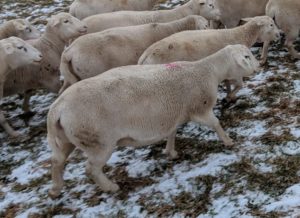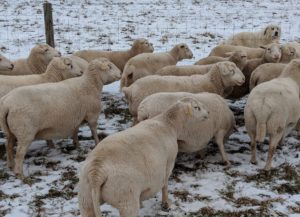How Crayons Inspired My Sheep Tracking System
An introduction on how to use color and number code ear tags for sheep.

All daughters of White Dorper ram #88 “Paul” have spearmint-colored ear tags. His daughter in the picture was born in 2017 as the 7000 number will tell me. Ulf Kintzel / White Clover Sheep Farm
The USDA decided years ago to combat Scrapie, a disease similar to Mad Cow Disease that affects sheep and goats. In its effort to do so, it became law in the United States that you must get a premise ID number for your sheep farm and tag your sheep with scrapie-approved ear tags. The tags have consecutive numbers when these sheep are older than 18 months and leave the farm, or for lambs and sheep of any age when they go across state borders. The idea behind the program is to trace animals that are tested and are determined to be affected with Scrapie back to its owners. The link at the end of the article describes this mandatory program, which includes a factsheet.
I used to not tag my sheep. However, if life gives you lemons, I figured I might as well make lemonade. So, I got creative with these ear tags, the available colors, and the numbers to trace animals and bloodlines. Since the inception of these mandatory scrapie tags, I started selling a lot of breeding stock. Because returning customers need new bloodlines on their way forward, using ear tags became a necessity. While a burden to many, using ear tags became a blessing in disguise for me. I developed a tagging system with color codes and number codes. I never felt compelled to share this system because it is indeed a bit cumbersome. However, it has become more frequent that I am asked how I keep track of the bloodlines of my ewe lambs, who sired them, and how to avoid inbreeding.
If you are one of those farmers who has impeccable bookkeeping skills and keeps track of every ewe and its lineage, and can access that information easily, my article will be of little to no value to you. If you have just a few animals that may even have names, my system will be unnecessary. But for all those who have a somewhat larger flock and are a little lazier like me when it comes to paperwork and documentation, here is the description of my system.
Several companies are listed as suppliers of these scrapie-approved ear tags such as Allflex, Alliance ID, National Band & Tag Company, Premier One Supplies, and Shearwell Data. Currently, I am using custom-printed Q-tags 1.5 sold by Premier One Supplies. Two different taggers work for these tags. I am using the universal ear tag applicator from Allflex, which works for many different tags.
I tag all my lambs during the first day of their lives when the ewes are for 24 hours in the jug with their new-born lambs for bonding purpose. The starting point for my tagging system is that all male lambs get tagged in the left ear while all female lambs get tagged in the right ear. I use my chute often when I treat animals, such as deworming and vaccinating. However, I use the chute far more often to sort out lambs that get sold as market lambs or breeding stock. As the sheep and lambs come up in the chute, I can determine in a split second what is male and what is female. That is helpful.
The tags I use for the ewe lambs are color-coded. For each ram I use for breeding, there is a color. For instance, all ewe lambs sired by ram number 174 “Nelson” are yellow, all ewe lambs sired by ram #88 “Paul” are spearmint-colored, all lambs sired by ram #41 “Outback” are salmon-colored and so forth. There are plenty of color choices available. I am confident that by the time I have used all colors I can start again from the beginning.
The numbers on tags of certain colors are much better to read than other colors when looking at a distance. For instance, the numbers on spearmint and yellow-colored tags are great to read from a distance, green and purple not so much. Also, some colors are somewhat similar and may become more similar when they start fading in the sun and will become indistinguishable. I recommend picking colors that are very different from each other. Blue is not available for scrapie tags because it is being reserved by the government.
As mentioned before, all ewe lambs get tagged in the right ear, the color of the tag indicates who the sire of each ewe lamb is. A select number of ram lambs that are born in any given year will be left intact and receive an ear tag with the color that indicates who the sire is in the left ear. The male lambs that will be market lambs will be castrated during tagging and will receive a white ear tag, also in the left ear. This may again sound cumbersome and one might think I would easily lose track over the colors and left versus right ear. However, my kids often help tagging and while they often cannot remember at all what I told them in the morning they should do that day, they do have an amazing ability to shout out all at once when I am about to tag a lamb the wrong way. They remember that, go figure.

The yellow color of the ear tag indicates this is a daughter of White Dorper Ram #174 “Nelson.” The 7000 number indicates she was born in 2017. Ulf Kintzel / White Clover Sheep Farm.
The second “code” are the numbers. Numbers on scrapie-approved tags must have at least four digits. The lowest number is therefore 1,000. I decided that the first number indicates the year of birth. For instance, last year’s lamb crop has tags with numbers in 8,000 (2018) and this year’s lambs will have numbers in 9,000 (2019). The numbers that have been used stay on record with the company where you ordered your tags to avoid that any given number is being used twice when you order new tags. The consecutive numbers are both on the male and female side of the tag. The ID or premise number is also on the female side. When tagging, the male side of the tag should be on the upper side of the ear and the female side on the inner side. That is the correct way of tagging. Now the larger number is clearly visible on the upper and more visible side of the ear. The male part of the tag is inside the ear and is less likely to get caught on feeders and in brush and is therefore less likely to get ripped out of the ear.
Why do I have such a cumbersome system? First, I can avoid inbreeding. Furthermore, this management system allows me to sell ewe lambs as breeding stock with unrelated ram lambs to breed them. It also allows the customer to come back in future years to purchase additional ram lambs that are not related to any ewe or ram lamb they previously purchased. It also allows me to significantly extend the use of my breeding rams, which were quite expensive and came from far away, from the state of Oregon. The purchase price and distance would be both cost-prohibitive to rotate rams more often. My system does require splitting the flock during breeding season into several group and keeping track of what ewe was bred by what ram. This will require using breeding harnesses, equipped with differently colored crayons or it will require marking the ewes of each group with a dot of spray paint on the wither. This will be addressed in my subsequent article in the next Quarterly. All of this is cumbersome, no doubt. However, it costs little to nothing. It does require some management skills and some additional work. The financial benefits become apparent in future years.
What do I do with all the left-over tags? I use them up in a following year for the ewe and ram lambs I intend to sell. When I do, I still apply my color code. It’s just that not every customer will be able to take advantage of my numbering system since the year of birth will be off. On occasion, a ewe will lose its ear tag. I use leftover ear tags for those as well. Often, I still know who the ewe’s sire was when I re-tag her and can use the corresponding color.
For more information about the mandatory Scarpie ear tag program, including a factsheet, visit https://www.aphis.usda.gov/aphis/ourfocus/animalhealth/animal-disease-information/sheep-and-goat-health/national-scrapie-eradication-program/nsep


This year I started color tagging my lambs according to the sire assigning a different color to each sire. We also started using up the blank tags we had for wethers destined for market. I don’t have many sheep, and my California scrapie tags are tiny which makes it difficult to read the wethers’ ID numbers when we weigh the lambs. The system is good, although with so few breeding ewes in my flock, using numbers in the 0000 series won’t work for us. I like the idea of tagging the wethers in the opposite ear than the ewes and will be doing that next lambing season (fall). I will also write the scrapie number on the white tag so they are legible for weighing purposes.
Your articles are wonderful to refer to.
Your ingenuity in utilizing color and number codes for sheep tracking is truly impressive. It is inspiring to see how necessity can spark such innovative solutions in farming practices.
Tarot Reading Services in Bakersfield